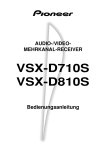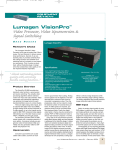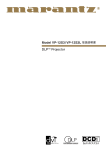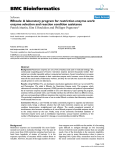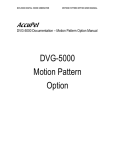Download Marantz VP-12S3 Specifications
Transcript
#84 Master Pages 26-49 3/22/04 4:30 PM Page 36 Equipment Review Marantz VP-12S3L High-Performance HD2+ DLP™ Video Projector G R E G R O G E R S Marantz VP-12S3L High-Performance HD2+ DLP™ Video Projector Third-Generation Technology Enhances Picture Quality The Marantz VP-12S3 is the company’s third-generation 720p single-chip DLP projector. It features new technology to increase contrast, lower black levels, and automatically calibrate its gray scale. There are short throw (VP-12S3 - $12,500) and long throw (VP-12S3L - $16,000) versions of the projector to accommodate different room sizes and placement requirements. A VP12S3L was provided for this review. “I was particularly impressed by the color accuracy and the brilliance of color detail on network broadcasts and D-Theater movies” Specifications: Innovation The VP-12S3 utilizes Texas Instruments’ HD2+ Digital Light Processing™ technology, a 7-segment 5x-speed color wheel, and custom Minolta optics with a remote-controlled twoposition iris that dramatically improves the contrast ratio and black level, compared to previous generation HD2 DLP projectors. In addition, the 200-watt SHP projection lamp is now DC powered to make it less prone to flicker. The projector’s most innovative new feature is a unique gray scale auto-calibration system. Each projector includes a color analyzer pod that temporarily snaps over the lens like a lens cap. The auto calibration system generates appropriate test patterns and reads data from the color analyzer pod through a cable that attaches to the rear panel RS-232 port. The projector also incorporates a color correction filter (ORCA™) to remove excess yellow from the light that passes through the color wheel. A more neutral white light is said to improve the color palette accuracy and the green primary color in particular. 36 Texas Instruments HD2+ Digital Light Processing™ Technology High Definition 1280 x 720 DMD™ Semiconductor Lamp: 200 W SHP DC Powered Lens: f: 26.5 to 30.7 / F: 3.0 - F:5.0 Contrast Ratio: > 3800:1 Light Output: > 700 ANSI LUMEN Typical Brightness Uniformity: 90% Long Life Lamp: (Average 2000 Hours) Video Inputs Composite Video:1 (RCA) Y/C: 1 (S-Video) Component: NTSC/ATSC 2 (3x RCA) RGB/HD: 1 (VGA D-Sub 15) DVI With HDCP: 1 (29 Digital Pin) In/Outputs RS232C: 1 (D-Sub 9) RC-5: 2 (3.5 mm mini) DC Trigger: 2 (3.5 mm mini) 6 Picture Modes: Theater, Standard, Dynamic, User A, User B, User C 5 Preset User Gammas 18 Picture Memories 4 Aspect Modes 5 Color Temperatures Black Level Selection Economy Lamp Mode No Light Leakage (Double Sealed Cabinet Structure) Extremely Quiet (Noise Canceling Construction, Sealed Color Wheel Motor) Power Requirement AC 100-120 V / 220-240 V, 50/60 Hz Power Consumption: < 300 W Dimensions (WDH In Inches): 15 15/16 x 18 9/16 x 5 3/16 (excluding feet) Weight (In Pounds): 26.1 Price: VP-12S3 $12,500 (short throw lens) VP-12S3L $16,000 (long throw lens) Manufactured In Japan For: Features Lens Up/Down Shift Adjustable Iris Video Processing Using Faroudja® Processing with DCDi™ Enhancement 2-3 Pulldown Progressive Scan Film Detection 10-bit Digital Gamma Processing Horizontal and Vertical Keystone Correction Widescreen Review • Issue 84 • May 2004 Marantz America, Inc. 1100 Maplewood Drive Itasca, Illinois 60143 Tel: 630 741 0300 www.marantz.com Page 1/7 #84 Master Pages 26-49 3/22/04 4:30 PM Page 38 Equipment Review Appearance The projector has a light gray case with a sparkly metal-flake finish. A somewhat darker bezel surrounds the larger than normal lens assembly, which is slightly offset from the center of the projector. The fans exhaust warm air through the front bezel. A manual lens shift dial is located on top of the case, along with a set of operating controls. All inputs are on the recessed rear panel. Setup A 16:9 (1.78:1) screen should be used to match the projector’s native aspect ratio. With a 100-inch diagonal (87 3/16-inch x 49-inch) screen, the short throw Minolta zoom lens provides a lens-to-screen throw distance of between 10 feet 9 inches and 12 feet 6 inches. The long throw zoom lens provides a throw distance of between 16 feet 8 inches and 22 feet 7 inches. Focus and zoom are manual adjustments—not available from the remote control. The mechanical lens shift function permits the center of the lens to be mounted anywhere between the top and bottom edge of the screen, regardless of whether the projector is ceiling mounted or table mounted. The projector can be tilted if it must be located above or below the screen, but this will cause the picture to keystone. Electronic Keystone Correction can be used to restore the image to a rectangle, but keystone correction produces moiré patterns on closely spaced lines, so it should be avoided if possible. Connections The rear panel has six video inputs— one composite (RCA connector), one Svideo (4-pin mini-DIN), two YPbPr (RCA connectors), one RGB (15-pin D-sub), and a DVI-D input. The YPbPr component video inputs accept standard-definition or highdefinition signals. The RGB input accepts signals with positive or negative HV sync, but not sync on green. The DVI-D input, which includes HDCP (High-Definition Content Protection), can be configured in a menu to accept digital RGB or YCbCr signals. The latter can be set for standard or high-definition color decoding. You can select the Normal mode for DVI signals with RGB-Video levels (black at digital code 16 and 100 IRE at 235), or the Extend mode for RGB-PC levels (black at 0 and 100 IRE at 255). The black level is switched correctly, but you will want to re-adjust the contrast levels if you switch signal types. The YPbPr inputs are compatible with 480i/p, 540p, 576i/p, 720p, 1035i, and 1080i 38 video formats. In addition to the usual 50, 59.94, and 60 Hz field and frame rates, the projector also displays 48 Hz 720p and 1080i signals at their native vertical rates. (I wasn’t able to try that feature.) The analog RGB input is compatible with the same video formats, and 60 Hz PC display formats up to 1024 x 768. According to the manual, PC formats at other vertical rates will be accepted, but not displayed properly. The DVI digital input accepts the same video formats and 60 Hz PC formats. The rear panel includes an RS-232C control port, and Remote Control In and Out jacks for connection to a Marantz audio component. There are also two 12V Trigger output terminals. One is active whenever the projector is turned on, and the user can specify which aspect ratios enable the other 12V output to control screen masks. The rear panel also includes a standard three-prong power cable socket and a light switch that illuminates the rear panel for changing cables in a dark room. That much appreciated feature even works when the projector is in standby mode. Controls The slender 1.75-inch-wide remote control is logically laid out, but only seven of the 25 buttons are backlit. Those include the Menu, V-Mute (picture mute), Input, Aspect, Pattern, Standby, and Power On buttons. There are also six dedicated input buttons, four Aspect Ratio buttons, and four buttons that select Picture Modes. Onscreen menu items are navigated and selected with a tilting cursor-pad button. There are also buttons for changing the deinterlacing mode and displaying status information. The Standby button is an annoying operator trap that immediately turns off the projection lamp without asking for conformation. If it is pressed accidentally you must wait for the entire cooling off period before the projector can be turned back on again. The top of the projector includes an alternate set of buttons for on-screen menu navigation, input selection, the focus pattern, and Power On/Standby. There are also Warning/Lamp, Power, and Standby indicators. The maximum lamp life is 2,000 hours, but Marantz recommends replacing the lamp after 1,000 hours. The lamp is user replaceable. On-Screen Menus The on-screen menus are arranged in hierarchical levels. The Main menu includes Picture Adjust, Setting, System, Display, Config, Trigger 2, and Preset. The Picture Adjust submenu provides Widescreen Review • Issue 84 • May 2004 Contrast, Brightness, Color (Saturation), Tint (Hue), Sharpness, Noise Reduction, Color Temperature, and Fine Menu. When a variable Picture Adjust item is selected, the menu disappears and is replaced by a single bar graph and numerical value near the bottom center of the screen, which makes it easier to perform adjustments without part of the picture being covered. When the adjustment is completed the menu reappears. The Picture Adjust items change depending on the input and the signal format. For example, the Tint and Noise Reduction controls are only available for composite and S-video signals. The Fine Menu item produces a submenu that includes Luminance, Chrominance, Sub Control, and Miscellaneous. The first two items provide a large number of adjustments for detail and edge enhancement. I’ll discuss those in a separate section. The Sub Control item produces a menu that includes red, green, and blue (RGB) Contrast and Bright controls, which are equivalent to the usual RGB Gain and Bias controls for adjusting color temperature and grayscale tracking. There are also Clamp Width and Clamp Position adjustments for analog RGB signals, which can be useful for signals that have non-standard timing. The Miscellaneous item produces a menu that includes DCDi™ (On/Off), CCS (cross color suppression) (On/Off), FRC (frame rate conversion) (Auto/On), and Sharpness Filter (0-4). The Setting submenu includes Lamp mode (High/Low), High Bright (On/Off), Aspect Ratio, VCR mode (On/Off), Cinema (Auto/Off), Iris (5.0/3.0), and Black Setup. The Lamp mode changes the lamp brightness by switching the lamp power. The High Bright mode increases brightness by producing an overly blue gray scale and should be avoided for critical viewing. The VCR mode is for poor quality video sources. It forces the projector to use intra-field vertical interpolation for deinterlacing and should be left off for DVDs and most broadcast video. The Cinema mode enables inverse-telecine deinterlacing for standarddefinition film sources. The F5.0 Iris mode maximizes the contrast ratio at the expense of picture brightness. Black level setup selects a 0 IRE or 7.5 IRE black level for analog input signals, and RGB-video or RGB-PC levels for DVI signals. The System submenu selects the signal format (Auto, NTSC, PAL, 480i, 720p, etc.) for each input, but the Auto value worked fine for all of my sources. This menu also provides RGB or YCbCr (standard or high definition) selection for the DVI input. The Display submenu includes Vertical and Horizontal Keystone, Auto Adjust, Vertical and Horizontal Size and Position, and Phase. Page 2/7 #84 Master Pages 26-49 3/22/04 4:31 PM Page 40 Equipment Review Auto Adjust determines the Size, Position and Phase settings automatically for analog RGB signals. The Config submenu includes Auto Power Off, OSD Position, Language (6 choices), Ceiling (mount) (On/Off), Rear (projection) (On/Off), Color Temp Calibration, Reset Lamp Life, and Reset All. The Trigger 2 submenu selects the Aspect Ratios that enable the 12V Trigger 2 output terminal. The Preset submenu selects the Picture Mode (Theater, Standard, Dynamic, User A/B/C), Index (1, 2, 3, Default), and Gamma (A, B, C, D, E, a, b, c). The Gamma setting can only be selected for the User picture modes. Lamp Mode The Lamp mode selects the brightness of projection lamp. This is one of the quietest projectors I have measured. In the High Lamp mode, the fan noise measured only 51 dB, C-weighted at 12 inches from the front (exhaust side) of the projector. The noise level dropped below the 50 dB sensitivity of my sound level meter in the Low Lamp mode. Picture Modes Each of the six picture modes (Theater, Standard, Dynamic, User A/B/C) stores three sets (Index 1-3) of Picture Adjust settings and a gamma mode. These are global settings that can be used with any input. When an input is switched, the picture mode and index last used with that input are restored. Gamma There are eight preset gamma curves (A-E, a-c). The gamma curves for the Theater, Standard, and Dynamic picture modes are ‘a’, ‘b,’ and ‘c’ respectively. Any of the eight gamma curves can be selected for the User picture modes. The ‘A’ and ‘B’ gamma curve values are relatively constant (about 1.62 and 1.73 40 respectively) from 10-60 IRE and then fall off at higher signal levels. The ‘C’, ‘D,’ and ‘E’ gamma curve values rise below 20 IRE (to about 2.02, 2.09, and 2.11 at 10 IRE) and are relatively constant (about 1.85, 1.75, and 1.85) to about 70 IRE before falling off. Therefore, dark image areas appear darker as the gamma changes from ‘A’ to ‘E.’ The ‘a’ curve is much like ‘A’ (about 1.64) with a slight gamma increase at the dark end. The ‘b’ curve is relatively flat with an average gamma of about 1.83, and the ‘c’ curve is nearly the same as ‘C’ without falling off at the bright end. These are all unusually low gamma values. A display gamma of 2.2 is required to produce a system gamma of 1.0, and as I’ve indicated in previous reviews a system gamma of 1.1 to 1.2 is advantageous when viewing a picture with a dark surround. That requires a display gamma of 2.45 to 2.67. I prefer a display gamma of about 2.5. On this projector I preferred the ‘c’ gamma curve even though ‘E’ had a higher gamma at 10 IRE. I wasn’t sure why until I realized that the brightest parts of the picture (above 70 IRE) were compressed (too bright) because the gamma falls off at the top of the ‘E’ curve. That bothered me more than the additional brightness at the dark end of the gamma curve, which makes shadow details more visible, but leaves some images a bit flat with too little contrast. There are no controls to modify the preset gamma curves, but the manual mentions that special PC software can be used to create custom curves. That software was not available at time of the review. Aspect Ratios There are four Aspect (ratio) Modes— Full, Normal, Zoom, and Through. The Full mode is used to display 16:9 sources— HDTV (720p/1080i) and 16:9 (anamorphic) DVDs. The Normal mode is used to correctly display full frame 4:3 (1.33:1) pictures in Widescreen Review • Issue 84 • May 2004 the center of a 16:9 screen with black sidebars. The Zoom mode is used to display 4:3 letterboxed pictures by expanding the image proportionally in the vertical and horizontal directions to fill the width of the screen. The Through mode displays any format with less than 720 vertical lines (or pixels) in its native pixel resolution without scaling the image. There is no mode to nonlinearly stretch a 4:3 image to fill the screen. Gray Scale A custom color analyzer pod is included to automatically calibrate the projector’s grayscale. The color analyzer pod snaps over the lens like a lens cap, and has a cable that plugs into the RS-232 port on the projector’s rear panel. To perform an automatic calibration the user only needs to initialize the sensor, center the lens shift adjustment, snap the color analyzer over the lens, and press a button. About 5 minutes later the process is complete. After running the auto calibration I measured a gray scale of 6601K +267/-8K from 20-100 IRE. There was a 5-8 dE (delta-E) deviation from D65 (x = 0.3127, y = 0.329) over that range. The color temperature increased to 7408K at 10 IRE with a dE of 17. I manually calibrated the Color Temperature and gray scale tracking to match D65 using the red, green, and blue Contrast (gain) and Bright (offset) adjustments in the Fine Picture menu. The manually calibrated gray scale measured 6500K +47/-49K from 20-100 IRE, and 6702 at 10 IRE. More importantly, the gray scale deviation from D65 measured just 0-2 dE from 20-100 IRE, and 4 dE at 10 IRE. Black Level And Contrast Ratio An AccuPel HDG-3000 Calibration generator (www.accupel.com) was used to generate test patterns for measuring grayscale, Page 3/7 #84 Master Pages 26-49 3/22/04 4:31 PM Page 42 Equipment Review contrast ratio, and color accuracy. Measurements were made after adjusting for the maximum calibrated light output (Contrast control) with a peak-white PLUGE pattern (98 IRE stripe against a 100 IRE background), and the optimum black level (Brightness control) with a conventional PLUGE pattern. With the gray scale manually calibrated to D65, the F5.0 (high contrast)/Low Lamp mode produced 13.4 fL from my 1.3 gain, 85.3-inch wide, 16:9 Stewart Filmscreen, which slightly exceeds the 12 foot-Lambert (fL) SMPTE recommendation for digital cinema. The on/off contrast ratio measured an exceptional 3005:1, which produced an absolute black level of just 0.0045 fL when displaying a 0 IRE (black) field. The F3.0/Low Lamp mode produced 16.6 fL from my screen, and a still excellent on/off contrast ratio of 2104:1. That mode could be used on slightly larger screens if the F5.0 mode produced too dim of a picture. The High Lamp mode can also be used for larger screens, but remember that a lamp may lose 40 to 50 percent of its light output over its useful life. So it’s a good idea to plan your screen size with the Low Lamp mode, and reserve the High Lamp mode for use during the latter part of the lamp’s life. The High Lamp mode increased brightness by about 25 percent. The F5.0 mode produced 16.9 fL, and the F3.0 mode produced 20.7 fL from the 1.3 gain screen. The latter is equivalent to about 454 lumens. If additional brightness is desired for viewing sports in a dimly lit room, the High Bright mode can be enabled. It increased the brightness about 20 percent, but the color temperature increased to over 10,000K. The on/off contrast ratio is extremely important for DLP and LCD projectors because it determines the absolute blackest level in the darkest scenes. A tiny increase in the black level dramatically reduces shadow detail discrimination in a predominantly dark scene. I also find it objectionable if the “black” background in an image is noticeably brighter than the black surrounding the screen. A distinctly different picture quality factor is the ability to see contrast differences when there are bright objects in a scene. Then the displayable contrast ratio is much less than the on/off contrast ratio because light from the bright objects will be scattered over the image obscuring darker objects. The light scattering occurs within the lens and the optical system of the projector, but it may also occur within your theatre as light reflects around the room and back onto the screen. There is no single measurement that can precisely describe this intra-field contrast ratio for all images because it depends on 42 the size and location of one or more bright objects within each individual image. Hence we can only define a figure-of-merit based on an artificial test pattern. One such figureof-merit is the ANSI contrast ratio, which involves measuring 16 blocks (8 white and 8 black) of a 4 x 4 checkerboard image and then computing the contrast ratio from the average luminance of the white and black blocks. This is laborious and fraught with practical measurement uncertainties. I’m using a modified “ANSI” measurement that is the average contrast ratio of the four central blocks in the 4 x 4 checkerboard. The contrast ratio for each block is measured separately by fixing the position and angle of the light meter a few feet in front of the projector, and then electronically reversing the black and white blocks of the checkerboard pattern. This increases the magnitude of the “black” values to minimize the influence of room reflections and improves the computational accuracy. It also eliminates other issues related to making measurements off the screen. Starting with this issue I will include this modified “ANSI” contrast ratio measurement in each projector review. The VP-12S3L measured 604:1. The only other HD2+ DLP projector that I have reviewed measured 728:1. This is outstanding performance for both products. As video levels approach black, dithering noise has been another significant problem in earlier generation DLP projectors. An excellent way to look for dithering noise is to view the 1-10 IRE 10-step luma patterns from the AccuPel generator. Dithering noise was visible on the 1 to 3 IRE steps of the luma pattern when viewed close to the screen, but it was nearly invisible from a normal seating distance. White Field Uniformity Brightness uniformity on a white-field test pattern was extraordinary. There was only a 1 percent variation in brightness from the top to bottom center of the screen, and 7 percent or less from side to side for both the F3.0 and F5.0 contrast modes. The color temperature uniformity was within 70K over most of the screen, with a variation of about 230K at one edge in both modes. Color Accuracy The CIE x,y diagram shows the 720p DVI RGB color accuracy compared to the Rec. 709 (HDTV) colorimetry. The same measurements are also shown on a CIE u’,v’ diagram, which provides a more perceptually uniform presentation of the color space. The projector primaries are slightly more saturated than the HDTV primaries, Widescreen Review • Issue 84 • May 2004 but they are balanced so that the position of the yellow, cyan and magenta complementary colors are extremely close to the standard colors. The hues of flesh tones and the other colors within the color gamut are quite accurate and images are brilliantly vivid. The CIE u’,v’ diagram for the 480i YPbPr input shows that the complementary color hues are still extremely accurate, even though the red primary is a bit farther outside the Rec. 601 primary for standard-definition video. You will likely want to use the YPbPr (or S-video) input, which provides a Color control if reds are oversaturated or too vivid on some video broadcasts or a DVD. Edge And Detail Enhancement The projector includes more than a dozen adjustments for edge and detail enhancement that separately affect luma and chroma portions of the image. The Luminance submenu in the Fine Menu includes eight adjustments for the Gain and Threshold of the horizontal and vertical Edge and Detail enhancement. The Chrominance submenu includes additional adjustments for Horizontal Edge Gain and Threshold, Vertical Edge Gain, Enhancement, and Delay. The Enhancement item is only enabled for composite and S-video signals. The Threshold adjustments determine the minimum luma or chroma amplitudes that the enhancement processing will affect. The Gain adjustments control how much enhancement is applied to edges or fine details. The Sharpness control (in the Picture Adjust menu) acts like a master gain control for the Luminance enhancement processing. If the Sharpness control, or all of the Luminance enhancement gain controls are set to zero, there is no luma enhancement. As the Sharpness control is increased, the enhancement increases proportional to the individual Luminance enhancement gain settings. The Sharpness control appears to work more like an on-off switch for the Chrominance enhancement. If the Sharpness is set to zero, the Chrominance gain adjustments seem to have no effect. But if the Sharpness is set to ‘1’ or higher, the Chrominance gain adjustments take full effect. When the Enhancement item is enabled, it appears to have master control over the Chrominance gain adjustments. Even when the Sharpness control and the other Chrominance gain adjustments are set to zero, there appears to be some chroma edge enhancement on the Pb channel. The leading edge transitions of blue patches in the Snell & Wilcox pattern of Video Essentials appear to be shortened, and the Y/C delay pattern on AVIA: Guide Page 4/7 #84 Master Pages 26-49 3/22/04 4:32 PM Page 44 Equipment Review To Home Theater indicates a delay in the blue channel. But the latter could also be a result of shortening the leading edge transitions. In any event, I couldn’t identify any related image degradation or color fringing artifacts on DVD movies. You can spend your rainy afternoons individually optimizing these adjustments for your DVD collection, or you could try the default settings that are loaded when you select one of the predefined Picture modes. I found all of the default Picture mode settings to be much too aggressive, but you might want to start with them and use the Sharpness control to modify the overall processing gain. For most of my DVD collection I ended up setting the Sharpness control to ‘1’ with very small individual enhancement gain settings, or at zero to bypass the enhancement. But there were a few DVDs with rather soft transfers that I used some additional enhancement to an advantage. The Luminance and Chrominance enhancement processing is not available for analog RGB or DVI signals. For those inputs a separate Sharpness Filter is added to the Miscellaneous menu. It has 5 settings (0 to 4) where ‘0’ produces no edge enhancement. The Delay control in the Chrominance submenu was not useful. It is intended to delay the color signals relative to the luma signal, but it also separated the luma signal into multiple color components creating an effect that resembles misconvergence on a CRT projector. Hence the Delay control should always be left at its zero (default) position. Standard-Definition Scaling Scaling performance varies depending on the input signal type and format. The analog 480i YPbPr scaling is excellent. With the Sharpness control turned off (zero) outlining around horizontal and vertical edges is only about 1 to 2 native (720p) pixels, and there is no additional visible ringing. The 6.75 MHz burst (single-pixel black and white vertical lines) from the AccuPel generator had negligible bandwidth loss and little aliasing. Overscan varied between 2 to 2.5 percent top and bottom, and 3 to 3.5 percent on the sides. The analog RGB input also accepts 480i signals, but the deinterlacing is poor (not done by the Faroudja components) and I wouldn’t recommend using it. The appearance of 480p YPbPr signals was not as good. Outlining around horizontal edges was just 1 to 2 pixels, as it was with 480i signals. But there were 4 to 5 (720p) pixels of outlining on vertical edges and additional ringing when fed fast signal transitions from the generator. I don’t believe this was a scaling effect, but rather 44 an issue in the analog 480p YPbPr signal path, because 480p RGB signals looked very good. The fast signal transitions are typical of a PC video card. When the AccuPel generator’s slower edge transition option was used, the outlining was reduced but still visible. The top burst in the multiburst pattern showed only a slight roll-off in frequency response. Overscan was 3.5 percent on the sides, and 2.5 percent top and bottom. The DVI digital video input had no problem with 480p signals and provided exceptionally good scaling with the Sharpness Filter set to zero. There were only 1 to 2 (720p) pixels of outlining on horizontal and vertical edges, and all of the bursts in the multiburst pattern looked excellent. In addition there was no overscan—not a pixel was lost at the top, bottom, or sides of the image. The S-video chroma bandwidth is excellent. The 1.5 MHz chroma stripes on Video Essentials’ Snell & Wilcox test pattern were bright, although not equivalent to the frequency response of the YPbPr signals. So you should still use YPbPr signals from a DVD player or a digital broadcast receiver when they are available. High-Definition Scaling The projector produces a spatially “pixel perfect” image when its DVI input is driven by 720p video signals from an AccuPel Calibration Generator. Each active (visible) pixel from the source is mapped to a single projector pixel. There is not a single pixel of overscan or underscan. The single pixel lines within a multiburst pattern are precisely rendered as single pixel lines with full resolution. The Sharpness Filter is disabled when the DVI (or analog RGB) input receives 720p signals. The DVI input also worked well for 1080i digital signals. There were only 1 to 2 pixels of faint outlining on vertical and horizontal lines in the Sharpness pattern, with 1 to 2 pixels missing at the edges. However, the combined effect of the 1080i deinterlacing (vertical-interpolation) and scaling could be seen on the overscan patterns, where some of the horizontal lines were 3 to 4 pixels thick. The Sharpness Filter had little effect on the 1080i edges, but it affected the mulitburst response. The top burst (1920 pixels per picture width) was necessarily aliased, but the filter rolled off the aliasing when set below 4. The default (2) setting was best, below that the frequency response of the previous burst also began to roll off. When the analog YPbPr input is used for 720p signals, the projector scales the image to create about 1 to 1.5 percent overscan on each edge of the screen. The signals Widescreen Review • Issue 84 • May 2004 are apparently filtered and produce no visible lines in the top two bursts of the AccuPel 720p multiburst pattern, which means that the horizontal resolution is below 640 pixels per picture width. There is also significant outlining (about 6 pixels) on vertical edges and additional ringing. Slower edges only slightly reduce the outlining artifacts. The analog YPbPr input performs similarly with 1080i signals. There are 4 to 5 pixels of outlining, and the overscan is about 1 percent on each edge. Again there are no visible lines in the top two bursts of the multiburst pattern, which means that the horizontal resolution is below 960 pixels per picture width. Because of the poor frequency response, I would avoid using the YPbPr inputs for high-definition signals and use the DVI or RGB input instead. The analog RGB input does a much better job with 720p and 1080i signals. When the slower AccuPel edge mode is used, which is equivalent to a high-definition settop box, the edge outlining is acceptably faint. But when the faster edge mode is used, which is similar to most PC video cards, the edge outlining was about 8 pixels to the right of vertical edges on 720p signals (5 to 7 pixels on 1080i) and there is additional ringing. So I would avoid the analog output of unfiltered PC video cards. The 720p single pixel lines in the top burst of the AccuPel multiburst pattern showed good resolution and depth of modulation. The single pixel lines in the 1080i multiburst were aliased. The Sharpness filter is enabled for 1080i and the best setting was the default (2) setting, as it was for 1080i DVI signals. The Auto Adjust feature worked well, and produced an image with no overscan or missing pixels for 720p. With 1080i analog signals there was 2 percent top and bottom overscan, 1 percent right edge, and none on the left edge. Deinterlacing The projector uses Faroudja deinterlacing technology, which includes film-mode (inverse-telecine) deinterlacing for standard-definition movies, and DCDi (Directional Correlational Deinterlacing) processing for standard-definition original interlaced video. Inverse-telecine deinterlacing provides artifact-free deinterlacing of film-source video as long as the video processor can lock onto the 2-3 field pulldown cadence that results from transferring 24 frame-persecond film to 60 field-per-second interlaced video. It also completely eliminates vertical interpolation in the deinterlacing process, thereby maintaining the full resoluPage 5/7 #84 Master Pages 26-49 3/22/04 4:32 PM Page 46 Equipment Review Marantz VP-12S3 Gray Scale Tracking 720p IRE Auto Manual Auto °K °K dE Manual dE 10 20 30 40 50 60 70 80 90 100 4 2 2 2 1 0 1 0 1 1 7408 6868 6608 6608 6601 6601 6601 6593 6593 6593 6702 6451 6532 6532 6547 6492 6485 6492 6547 6547 17 5 6 6 7 7 7 8 8 8 terlacing, and regardless of the technique there are always tradeoffs between line twitter, jaggies (static or moving stair-steps on edges), and a loss of picture resolution. The video segments of the Video Essentials “Montage” provide good sequences for comparing deinterlacers. Unlike many other deinterlacers, the DCDi processing completely eliminates jaggies on the bobbing frozen branch and the stripes of the rippling American flag. But the Faroudja processing appears to produce some color bleed between the red and white stripes of the flag. There is also more line twitter with vertical movement across horizontal lines in the train yard and during the zoom-out of the city. The DCDi processing does a good job of minimizing jaggies on most standard-definition broadcast programming, but it was less effective with fast motion sports. Jaggies and line twitter were bothersome on basketball broadcasts as the camera panned across lines and logos on the court, but they were much worse with the DCDi disabled. DVD Movies tion of the film-to-video transfer. The inversetelecine film-mode processing handled a wide range of DVD movies without any visible deinterlacing artifacts, and had no problems when jumping between DVD chapters. The Cinema mode must be enabled to use the film-mode deinterlacing. It will then automatically switch between inverse-telecine deinterlacing for film sources, and motion-adaptive deinterlacing (with or without DCDi) for original interlaced-video sources. The automatic switching worked seamlessly without any glitches or combing artifacts on the Video Essentials “Montage Of Images,” which cuts back and forth between segments transferred from film and original interlaced video. The DCDi processing uses directional interpolation to reduce jaggies along edges. The DCDi mode can be turned off in the Miscellaneous menu, and then the video mode deinterlacing uses only motion-adaptive deinterlacing. The VCR mode turns off the motion-adaptive deinterlacing for particular poor sources, and uses a field-based vertical interpolation algorithm regardless of video content. That creates a substantial loss of vertical resolution, and shouldn’t be used unless you find other deinterlacing artifacts with poor sources particularly objectionable. It is much more difficult to deinterlace original interlaced video sources than it is to deinterlace video from film sources. There are no ideal methods for video source dein- 46 I used the analog YPbPr and DVI digital video inputs to evaluate picture quality with DVD sources. All of my viewing was done in the F5.0 (highest) contrast mode with Low Lamp brightness. I was most impressed by with the superior image clarity, dark blacks, and vivid, accurate color. At least two factors are responsible for the exceptional clarity of the DVD images. The analog 480i and digital 480p scaling have minimal edge outlining, and the Minolta lens has superior focus and little vanishing chromatic aberration over the entire screen. Chromatic aberration produces color fringing on gray or white lines, similar to the effect of misconvergence on a CRT projector. Projectors in this price range are prone to have some chromatic aberration, which gets progressively worse toward the edges of the picture. But test patterns revealed that the VP-12S3L maintains sharply focused lines with virtually no color fringing out to the edges of the screen. That quality of performance is normally only found on much more expensive projectors that have a larger, more costly lens. (I did not have a VP-12S3 with the short throw lens to test.) It is hard to overstate the improvements that the HD2+ DMD™ (Digital Micromirror Device™), 7-segment color wheel, and new iris technology have brought to this generation of DLP projectors. The much lower black level lifts a hazy veil that had been a shroud over predominantly dark films, such as The Game or Dark City. Moreover, almost every movie contains some scenes that had previously been partially obscured by the Widescreen Review • Issue 84 • May 2004 black level of earlier generation projectors. There is also a similar improvement in intrafield contrast, which enhances dark detail recognition and image depth in scenes with extremely bright objects. Back To The Future and The Usual Suspects contain notable examples. In addition, those troublesome scenes are also free of visible contouring artifacts (discrete brightness steps in patterns resembling a topological map surrounding bright objects). The projector produces brilliant, vivid colors with accurate hues. But because the primaries are a little more saturated than the Rec. 601 standard-definition primaries, I slightly reduced the Color control for films with highly saturated reds or deep skin tones, such as The Thomas Crown Affair (1999) and Indiana Jones And The Last Crusade. The hues remain accurate and the colors are still vivid with a small reduction in color saturation (color depth). Many other films look glorious without any color adjustments. I especially like the warm, natural colors in Runaway Jury. The on-location images looked especially realistic, far surpassing the believability of the script. But the exchanges between Gene Hackman and Dustin Hoffman are wonderfully entertaining, and the DVD transfer has excellent detail that is superbly delineated by the projector (check out Hoffman’s sport coat). The unusually low gamma values can be seductive because they make the darkest image areas brighter and expose more shadow detail. But they also make dark interiors and exterior night scenes brighter than expected. I selected the ‘c’ gamma curve because it was the setting that produced the darkest shadow regions without compressing the brightest whites. I found it pleasing for the widest range of movies. It provided the most natural contrast for cruising the late-night streets of American Graffiti, and was the most convincing gamma for the lunar excavation and Discovery’s trip to Jupiter in 2001: A Space Odyssey. However, I wanted a higher, more conventional gamma for classic black and white films such as The Philadelphia Story, which appeared rather flat with insufficient contrast. I preferred a 480p or 720p DVI connection for the most highly detailed film-tovideo transfers. The digital video path provides a noticeable advantage in image definition compared to a 480i YPbPr analog connection, which must include an additional digital-to-analog and analog-to-digital conversion. But the advantage was less significant on DVDs with only average detail. In fact, the 480i analog path was advantageous on transfers with softer images because the luma and chroma enhancement processing, which is not available for Page 6/7 #84 Master Pages 26-49 3/22/04 4:33 PM Page 47 Equipment Review the DVI input, can improve the apparent picture definition if used judiciously. However, it is crucial to use a DVD player that has minimal edge outlining on its 480i analog output. It may also be necessary to use the analog YPbPr input if the movie contains extremely saturated red colors, because the DVI input does not include a Color saturation control. HDTV I used the DVI and analog RGB outputs of a Samsung SIR-T165 HDTV Receiver to feed high-definition broadcast video to the projector. The IEEE 1394 (i.Link®/FireWire®) output of a JVC HM-DH40000 D-VHS® DTheater™ VCR was also connected to the Samsung, which provided an entirely digital video path for high-definition D-Theater movies. My favorite D-Theater film transfer continues to be X-Men. Its exceptionally sharp edges and fine detail present a difficult challenge for 720p-native projectors. The VP-12S3L rendered X-Men with more definition than any DVD movie, but the image appeared slightly softened by the 1080i to 720p cross-conversion, and jaggies ran along diagonal edges during camera pans. The horizontal slats of a park bench also exhibited line twitter during vertical camera movement. I hope manufacturers will make it a top priority to incorporate inversetelecine deinterlacing for 1080i film sources in the next generation of DLP projectors. NBC’s The Tonight Show With Jay Leno continues to produce some of the finest HDTV images, and it looked striking on the Marantz projector. The cityscape backdrop was particularly impressive with its vivid colors and fine structure. The depth-of-field of the high-definition studio cameras maintain splendid focus, and the projector’s scaling produces very little edge outlining. But there is no motion adaptive deinterlacing for 1080i video, which somewhat softens the picture. The 1080i DVI signals produced slightly better definition than the analog RGB signals. I was particularly impressed by the color accuracy and the brilliance of color detail on network broadcasts and D-Theater movies. However, a few HDTV broadcasts pushed red saturation to the limit. Although I never found it seriously objectionable, it would have been desirable to make a small reduction in color saturation on some programs, which is not possible with the DVI or analog RGB inputs. In the F5.0 Low Lamp mode, with a peak brightness of 13.4 fL, there was virtually no visible pixelization or spurious digital noise other than a small amount of dithering on Page 7/7 47 the very darkest signals, which was virtually invisible from a normal viewing distance. Summary The Marantz VP-12S3L is a third-generation 720p DLP projector. It features Texas Instruments’ newest HD2+ DLP technology, which provides a dramatic improvement in black level and contrast ratio compared to previous generation DLP and LCD projectors. It also includes a unique gray scale auto calibration system to maintain consistent color accuracy. Faroudja deinterlacing, excellent scaling, and a superior Minolta long throw lens produce pristine image clarity for DVD movies from 480i YPbPr sources. The HDCP-equipped DVI digital video input is preferred for 480p and HDTV sources. ■■








